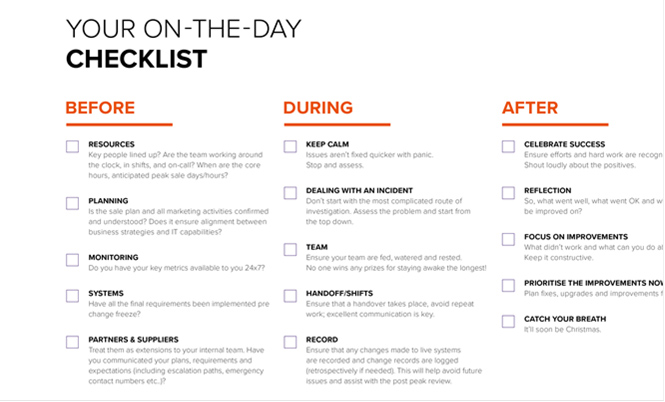It’s beginning to look a lot like Christmas, or rather Christmas shopping and the retail frenzy of Black Friday and Cyber Monday. Originating in the States immediately after Thanksgiving (which is on the third Thursday of November), it’s become a regular shopping event across the world, with brands knocking down prices to thwart competitors, and sharp-elbowed customers grabbing those deals fast. Sleep and you weep: in the past, some High Street shops have found they should’ve drafted in more staff and, online, surging traffic has caused some unprepared e-retail sites to wobble and crash; unforgivable errors that many customers don’t forget. How ready is your business and how stable your holiday marketing strategy?
I arranged to meet a friend in the famous ‘Lanes’ in Leicester, for a posh lunch and a bit of gentle retail therapy. It turned out we had blithely chosen Black Friday for our catch-up and the trains were rammed, the bars jammed and the shops stuffed fuller than a holiday turkey (we gave up and visited the Richard III burial site instead, which was delightfully quiet).
That ‘shopping’ trip was a few years ago and, since then, the Black Friday event has grown exponentially in popularity around the world with big discount deals by major stores luring price-savvy consumers – and even the smaller, niche boutiques jumping on the bandwagon with notable offers. In the UK last year, consumers went shopping (online and in-store) over the weekend – Black Friday through to Cyber Monday – and spent £5.8billion. In the US, sales have broken records every year since the recession eased, proving it is a major sales event only beaten, in terms of sheer force of numbers, by people who go shopping on Singles’ Day in China – a record-breaking $33billion this year on November 11.
International interest to spur your holiday marketing strategy
Black Friday 2017 will be bigger than ever, according to research by integrated marketing solutions company, Rakuten Marketing. With growth figures from 2016 showing a 14% year-on-year increase in sales globally compared to 2015, another upsurge is expected, perhaps influenced by a consequence of the Brexit vote – the weak pound and thus increased interest from foreign visitors.
 UK retailers should look across borders to reap rewards from this interest, said Mark Haviland (pictured left), EVP Global Development and MD of Rakuten Marketing Europe: “Marketers looking to make the most of this year’s sales peaks will see the biggest returns by marketing internationally. We’ve already seen this year how brands including Burberry, known to be quintessentially British, have taken advantage of the weakness of the pound since the vote to leave the EU, as tourists have flocked to buy products more cheaply in the UK.”
UK retailers should look across borders to reap rewards from this interest, said Mark Haviland (pictured left), EVP Global Development and MD of Rakuten Marketing Europe: “Marketers looking to make the most of this year’s sales peaks will see the biggest returns by marketing internationally. We’ve already seen this year how brands including Burberry, known to be quintessentially British, have taken advantage of the weakness of the pound since the vote to leave the EU, as tourists have flocked to buy products more cheaply in the UK.”
Rakuten research shows that as many as 24% of sales through UK publishers on Black Friday are now driven by international shoppers. This rises to 28% by Cyber Monday, with the US, Hong Kong and China making up 9% of this demand.
Spreading online demand
Cyber Monday – the online version of the physical Friday shopping frenzy – has proved to be frustrating for some e-consumers, who have experienced wobbly sites and pages that refuse to un-freeze. To counter this e-traffic jam, brands have extended their deal timeframes – Rakuten Marketing says ‘Cyber Week’ starts on the Monday preceding Black Friday, with the global number of orders placed just 9% short of those placed on the Friday.
Last year, the US saw 46% more sales on Cyber Monday – the Monday immediately following Black Friday – than Black Friday itself.For clothing and accessories, purchases take place 13% quicker than ordinary retail days, equivalent to cutting 19 hours off the customer journey. In the UK, Black Friday still delivers the greatest sales boost, a colossal 307% increase, compared to the average retail day in the first week of the month. However, Cyber Monday purchases take 17 hours less than Black Friday as consumers rush to make the most of deals before they expire.
Haviland repeated the need for a cross-border holiday marketing strategy: “UK brands looking to have a global presence should focus on Cyber Monday. With so many US shoppers hurrying to take advantage of favourable exchange rates, on top of sales discounts, there’s an enormous opportunity to engage beyond the domestic market.”
But he reminded brands to tread carefully and remain focused on the customer experience: “While conversions during winter sales peaks can seem almost immediate, it’s important to remember that the modern consumer journey is complex and there are many different kinds of shoppers your marketing efforts must cater for. The stores that win the retail battle are the ones that challenge assumptions of fast-paced domestic demand and take the steps to look across borders to understand their different audiences and markets.”
But beware counterfeiters
As retailers benefit from a global marketplace, there are also risks associated with shopping online. With more good deals to be had, how can bargain hunters scouring the internet ensure they are getting the real deal and not fake goods? Fraudsters target peak shopping periods and counterfeit goods are harder to spot because they are often priced at similar levels as the genuine item.
 Charlie Abrahams (pictured left), senior vice-president from online brand protection specialist MarkMonitor, said: “There used to be a belief that people were deliberately buying fakes as they are cheaper. But, last year, we found that 23% of bargain-hunters had been duped by counterfeiters. This showed a majority of these consumers were buying them by mistake. They are searching for bargains and in turn are buying counterfeit goods without knowing it.”
Charlie Abrahams (pictured left), senior vice-president from online brand protection specialist MarkMonitor, said: “There used to be a belief that people were deliberately buying fakes as they are cheaper. But, last year, we found that 23% of bargain-hunters had been duped by counterfeiters. This showed a majority of these consumers were buying them by mistake. They are searching for bargains and in turn are buying counterfeit goods without knowing it.”
MarkMonitor suggests these five key tips for consumers buying online:
- Price: Counterfeiters are wising up and realising that sometimes it can be more convincing the less the item is reduced. So search around for the recommended retail price (RRP) and, even if the item only has a small discount, such as 20%, it is worth checking other elements of the website to see if they stack up.
- The site itself: Although at first some websites look professional, counterfeiters aren’t always so careful about the ‘About’ or ‘FAQ’ pages. Check these sections and be sure to look at the delivery details, noting where the company is based; does it match up with the company’s details? Also, look at the delivery options – less reputable sites won’t bother with this.
- Returns and privacy policies: If it’s a reputable site, these should be clear. A bona fide seller should show how to cancel orders and where to return goods. Counterfeiters won’t usually take time to present a clear, strong privacy policy, so if there isn’t one on the website, be wary.
- Check the web address: Impersonation of a brand’s website and ‘cybersquatting’ are increasing. When doing an initial search for the brand name, check the link and look out for spelling mistakes on both the website and the URL. If that address begins with https:// the ‘s’ tells you it’s a secure site. Some of the bigger brands have pages on their sites so consumers can check a seller is authorised.
- Online marketplaces: Even if the marketplace is a brand you know, check reviews of the seller or try to find forum chats and speak to other retailers before placing an order.
But it’s not just consumers that should be vigilant – brands should read and digest the advice. MarkMonitor sums up: ‘Brands need to do all they can to protect their customers during this busy, high-risk time.’
Meanwhile, money tips from UK MoneySavingExpert.com – Martin Lewis – also guide consumers on how to spot Black Friday duds and deals: how to spot potential frauds, but also how to discern which retailers have risked their reputations by earlier putting up their prices in order to then dramatically slash them. Lewis said: “It’s one of the biggest online shopping days of the year and a good time to pick up Xmas gifts, but many Black Friday ‘deals’ are actually duds. Our Deals Hunters have been sorting the stonkers from the stinkers for years.” See how Lewis recommends consumers can ditch the duds and root out the deals this Black Friday.
‘Cherry-pickers’, acquisition and the burden for retailers
And there’s another drawback brands should consider – statistics reveal that holiday shoppers are 19% less likely to make a second purchase during the rest of the year. So is Black Friday actually cannibalising full price sales? Some major retailers think so and don’t join in: the CEO of retailer Next, Lord Wolfson, has referred to Black Friday as “pointless”. The company has recently revealed a 1.3% sales increase to counter its previous weak quarter and has therefore shrugged off pressure to take part in the Black Friday event.
 Pini Yakuel (pictured left), CEO of relationship marketing hub Optimove, understands that decision. He said: “Black Friday is increasingly seen as a burden for retailers, a way to keep up with the competition rather than an actual retail opportunity – especially by more traditional companies like Next. Certainly, heavy discounting on Black Friday is not that effective for customer acquisition. Customers who make their first purchase during the holiday season are 19% less likely to turn into repeat customers than customers who start shopping with you during the rest of the year.
Pini Yakuel (pictured left), CEO of relationship marketing hub Optimove, understands that decision. He said: “Black Friday is increasingly seen as a burden for retailers, a way to keep up with the competition rather than an actual retail opportunity – especially by more traditional companies like Next. Certainly, heavy discounting on Black Friday is not that effective for customer acquisition. Customers who make their first purchase during the holiday season are 19% less likely to turn into repeat customers than customers who start shopping with you during the rest of the year.
“But, if approached correctly, Black Friday can be a great opportunity for retailers to work on increasing revenue from their existing customers. In fact, about 71% of customers on Black Friday will be existing customers and these clients make 30% higher transactions over the Christmas period than new shoppers.
“From this perspective, the holiday season needs a different strategy. Retailers need to think about how discounting impacts acquisition.
“While minor discounts of 5-30 per cent do encourage shoppers to return for a second purchase, anything over 30% is more likely to encourage ‘cherry pickers’ – customers who will buy products at a highly discounted price, but are unlikely to return to buy anything at full price, and therefore don’t hold a lifetime value to the brand.
“The large amounts of data that retailers hold on their existing customers is key to marketing in a way that increases value from existing customers. By using this data to target existing shoppers, personalising and targeting discounts, offers and promotions, retailers can make the holiday work for them by upselling to their existing customers rather than selling at a loss to others who won’t return.
“It is better to use Black Friday and promotions around the holiday season as a way to keep your existing customers coming back, and making sure they aren’t drawn away by other competitors.”
Holiday marketing strategy, 2017 and beyond
Although Black Friday is seen by many retailers as a way to shift stock, make a quick profit and acquire new customers, experts agree that discounting strategies can create problems for retailers later on in the year. Advice for marketers is clear:
- Heavy discounts don’t necessarily attract loyal customers going forward – just bargain hunters. Make sure you know which you are aiming to achieve. Consider upselling to existing customers through personalised offers instead.
- Brands should ensure they do all they can to ensure their customers are protected from counterfeiters – is it absolutely clear you are a bona fide seller?
- Extend your offers beyond Black Friday or Cyber Monday, to ease the footfall burden – both on physical shops and on websites: offer discounts over the whole week, or at least over the whole weekend, rather than purely on the two specific days.

Salmon has tips to bear in mind when planning your holiday marketing strategy
And look out for the ‘Basket Bandits’
Data from global e-commerce consultancy Salmon shows that cart abandonment since 1st November – 14th November 2017 has increased by 4%. This increase in ‘Basket Bandits’ shows an increasing trend in consumers adding to their baskets, but waiting instead for the Black Friday sales to purchase. In this vein, conversion rate has also dropped since 1st November signalling that a higher percentage of sessions are not placing orders.
Salmon correctly predicted the first £1 billion online Black Friday in 2015 and believes Black Friday could soon become a month-long phenomenon that will overtake December as the biggest shopping month of the year, as retailers compete for a slice of the new ‘peak’ trading season.
 James Webster (pictured), head of managed services at Salmon, said: “Retailers should by now have put in place the proper planning, due diligence and system testing on their websites to cope with the Black Friday rush. The bargains are no longer confined to just one day though, or even one week necessarily. As companies such as Amazon stretch their deals further back to a fortnight, retailers should be preparing early to create an ongoing experience and grow that invaluable customer base and loyalty, pipping their competitors to the post.”
James Webster (pictured), head of managed services at Salmon, said: “Retailers should by now have put in place the proper planning, due diligence and system testing on their websites to cope with the Black Friday rush. The bargains are no longer confined to just one day though, or even one week necessarily. As companies such as Amazon stretch their deals further back to a fortnight, retailers should be preparing early to create an ongoing experience and grow that invaluable customer base and loyalty, pipping their competitors to the post.”
Have an opinion on this article? Please join in the discussion: the GMA is a community of data driven marketers and YOUR opinion counts.


 UK retailers should look across borders to reap rewards from this interest, said Mark Haviland (pictured left), EVP Global Development and MD of Rakuten Marketing Europe: “Marketers looking to make the most of this year’s sales peaks will see the biggest returns by marketing internationally. We’ve already seen this year how brands including
UK retailers should look across borders to reap rewards from this interest, said Mark Haviland (pictured left), EVP Global Development and MD of Rakuten Marketing Europe: “Marketers looking to make the most of this year’s sales peaks will see the biggest returns by marketing internationally. We’ve already seen this year how brands including  Charlie Abrahams (pictured left), senior vice-president from online brand protection specialist
Charlie Abrahams (pictured left), senior vice-president from online brand protection specialist  Pini Yakuel (pictured left), CEO of relationship marketing hub
Pini Yakuel (pictured left), CEO of relationship marketing hub 
 James Webster (pictured), head of managed services at Salmon, said: “Retailers should by now have put in place the proper planning, due diligence and system testing on their websites
James Webster (pictured), head of managed services at Salmon, said: “Retailers should by now have put in place the proper planning, due diligence and system testing on their websites 


Leave your thoughts